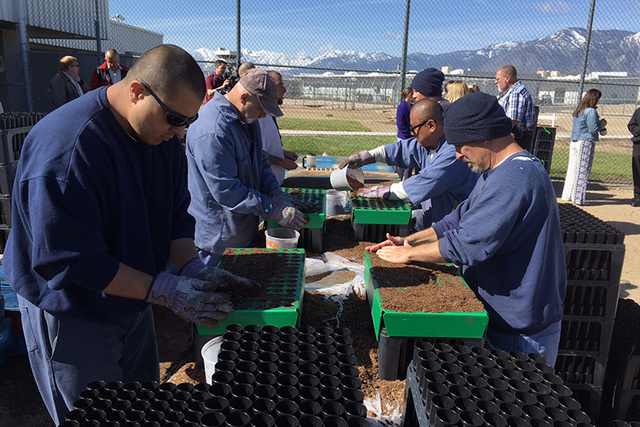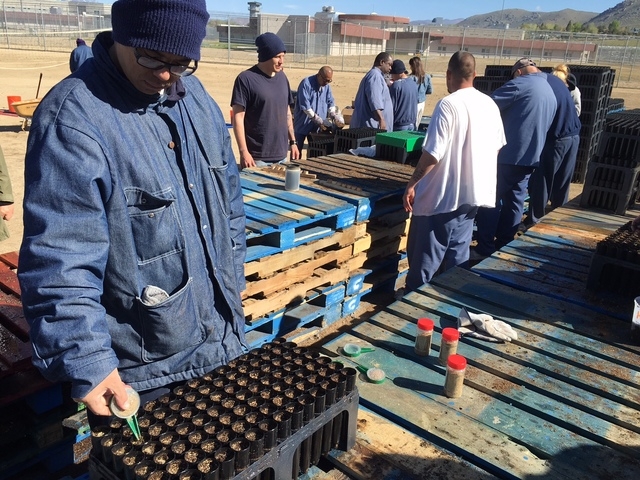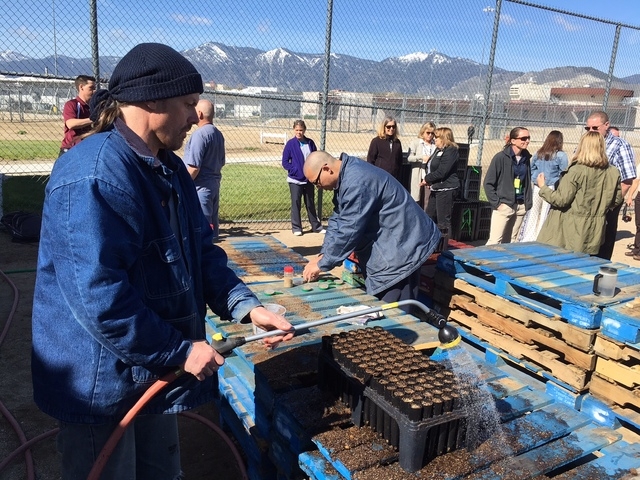Inmates and sagebrush helping to save sage grouse
CARSON CITY — The future of the sage grouse — a vulnerable game bird facing numerous threats to its existence — soon will benefit from an unlikely source: Nevada prison inmates.
Nevada Corrections Department officials and representatives of the U.S. Bureau of Land Management and the Institute for Applied Ecology last week visited the Northern Nevada Correctional Center, where a team of 15 inmates was busy preparing sagebrush seedlings that will be used for planting in fire-ravaged areas of the sage grouse habitat in Nevada and California.
About 105,000 plants will be readied at that prison and at Lovelock State Prison and Warms Springs Correctional Center. They will grow over the summer and be planted in the fall.
The Sagebrush in Prisons Project is underway at 11 prisons in six states.
“Greater sage grouse are at risk of being put on the endangered species list,” said Stacy Moore, ecological education program director with the nonprofit institute in Corvallis, Oregon. “This is a major concern for people in Nevada and across the West where sage grouse live.”
At the medium-security Northern Nevada Correctional Center, the inmates had a small assembly line.
Inmate Russell Strotz took a brief break from planting to explain the process, including fertilizing and watering the seeds before moving the containers to the prison yard to be tended over the next several months.
Strotz said he saw a flier about the program and applied. Helping the sage grouse is “pretty cool,” he said.
Rob Burton, natural resource specialist with the BLM’s Winnemucca District, said the hope is that planting sagebrush bushes rather than just trying to seed an area will be more successful in bringing back the habitat where fires have wiped out the native vegetation.
“The sage grouse is a keystone — a canary in the coal mine — species,” he said. “If we take care of the habitat for the sage grouse, then the pygmy rabbit, Preble’s shrew, antelope, the mule deer — everybody is going to benefit. We know a lot of the wildlife is having some problems out there with these large fires.”
Sage grouse live off sagebrush, Burton said. Without sagebrush, there won’t be any sage grouse, he said.
The project with the Corrections Department “isn’t an experiment, but it is a new model,” Burton said.
The greater sage grouse is found throughout much of northern and central Nevada and 10 other Western states, but its population has declined from about 16 million a century ago to fewer than 500,000 by some estimates.
The ground-dwelling bird measures up to 30 inches long and can stand 2 feet tall.
The U.S. Fish & Wildlife Service decided last year not to put the bird on the endangered species list, citing the many conservation efforts underway in Western states including Nevada.
Melanie Rasor, also with the Winnemucca BLM, said the sagebrush already in soil should do better when planted than bare-root plants.
“The containers have a higher success rate,” she said. “They should be very successful, hopefully, on the land.”
Fifty thousand plants will be used in the Winnemucca area.
Shannon Swim of the Institute for Applied Ecology is in charge of overseeing the seeding project at the prison. Inmates will learn about sagebrush ecology, she said.
“Inmates acquire horticulture and team-building skills at the same time they are helping restore sage grouse habitat on federal lands,” she said.
Darcy Davis, quality assurance manager for behavioral programs at the Corrections Department, said the opportunity to provide inmates with work on such a project will help them develop better social attitudes and behaviors. This in turn may reduce the likelihood of recidivism, she said.
Contact Sean Whaley at swhaley@reviewjournal.com or 775-461-3820. Find him on Twitter: @seanw801



















